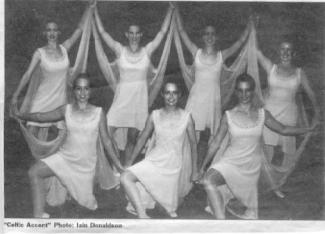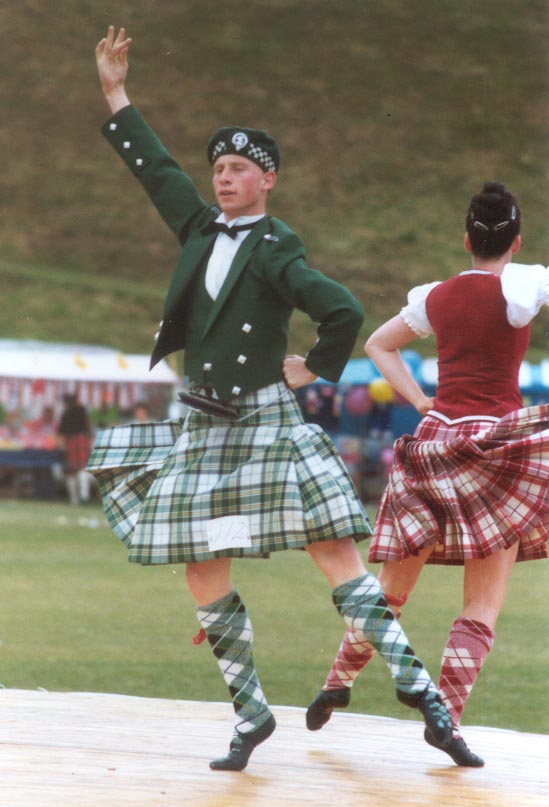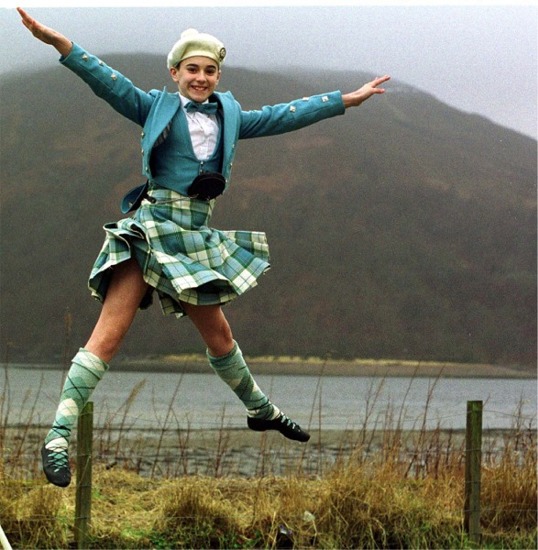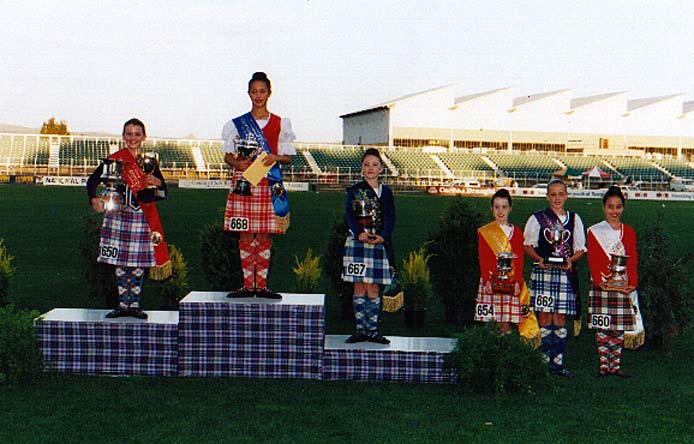The following article was written and appeared on the Celtic Cafe Irish Dance site, much has been said recently about the lack of marketing and success of Highland Dance. It has it's problems as readers will see. However due to the controversy over the article at least one professional company has been given exposure and interest in the "professional world of dance"
Why is Highland Dance Always the Bridesmaid to the Irish Dance Bride?
By Loraine Ritchey
It has been this writer's lot for many years to cover the Highland Dance scene on a worldwide basis for more than one magazine and to have been the mother of a Highland dancer. Whilst I am not an expert in the technical differences between the two or even in Highland itself, I am one of the very rare monthly columnist that have written about Highland on a continuous monthly basis for the past 9 years. (Articles may be found http://lritch7.tripod.com) The first step in understanding Highland dance is just what is it? Most people when you say you cover the Highland dance scene believe you are writing about "Irish Dancing" and those that do know the difference think you are referring to "Scottish Country Dancing" (for information on Scottish Country Dancing try http://www.strathspey.org
What, who, how many and why of Highland
So just what is Highland Dance? Even within the Highland Dancing world, which by Irish standards is extremely small, there is disagreement. However for the most part Highland Dance is primarily a "competitive art form" and not performance based. The dances danced competitively are limited; dancers perform and are judged as individuals. There are organizations in place that "govern" the competitive arena. The current largest organization Scottish Official Board of Highland Dancing "claims" it oversees over 50,000 dancers/ participants' worldwide and states in one program 25,000 of those based in North America. However, marketing aside, the numbers are closer to less than 7,000 in North America and more on the basis of around 15,000 worldwide.
Taking into account those figures the vast majority of dancers registered with the SOBHD are primary and beginners. The USA having only around 600 of the 2,000 odd registered dancers who have completed the various competitive levels, beginner, novice, intermediate to reach "Premier Status" with only a small percentage of those being over 18 you begin to see the problem. Numbers! Now ask yourself how many "Irish Dancers" are there in the USA? Those same numbers also tell what ratio of a "performance audience" is available to Highland dancers. As small as that pool is to draw from that is not the only problem. Dance, to be successful should be able to cross over the nationalistic line to entertain all audiences.
Steve McGrail a writer for 'Scottish Life' states in his article "New Lords of the Dance" (Scottish Life 1998) pointed out that "Irish Dancers had the audience clapping and stomping at the "Fair" whereas the Highland dancers audience seemed to be made up of mothers and polite applause". He goes on the ask, "Could it be the reason for the demise (Highland dancing) is boredom"
1998 and the question is still to be answered in 2003. Although the "spin doctors of the Highland world" tout great influx of numbers the truth is that the organizations numbers either remain just perking along or losing dancers. The 50,000 number has been thrown out for at least the last 10years by the President of the SOBHD, Billy Forsyth (himself a World Champion) but again this is just not an accurate accounting 10 years ago or today, no matter how the spin-doctors protest.
Still all it should take is one talented person or a" hook" to set the world on fire, it worked in the case of Irish dancing did it not? The over all appeal to audiences, Irish or not, was a force to be reckoned with.
Could Highland dance also find that niche, they have the Irish coat tails to grab on to? The way should be easier for another Celtic choreographed production storming of the stage. Highland too has some talented dancers with championship titles galore. In fact it has been tried, on more than one occasion, only to fail miserably, fade away after a few performances, or just perk along in the church halls and by ways for the small but appreciative "educated in Highland" audiences. These "shows" have never generated the excitement or audience numbers of even a third string, truck and bus Irish dance show.
Why is it that a "show" which had 7, count them, 7 World Champion Highland Dancers among it's performers and in front of an "educated in all things Highland" lost the standing ovation to the lesser titled and less talented (in this performance) Irish dancers. What made the audience jump to their feet for the Irish whereas the 7 World champions were greeted with warm but restrained applause? If this is the case, with an educated Highland audience who understood more than most the difficulty of the Highland routines being performed, what chance does Highland have with your average theatergoer?

Celtic Accent
Can it be the art form itself is it's own worst enemy? Over the decades the "competitive circuit," some say in order to make life easier for the adjudicators, has refined and cut steps and dances to a very few. In the case of the SOBHD their World Championship, Cowal Highland Gathering (the crown or cup that most Highland dancers wish to attain) is based on the same 4 dances year in and year out, steps cut down from years gone by to a 6 step Fling etc. The dancers are judged (SOBHD) on 80 % technique 10% costume and 10% left for the rest; mostly the focus is below the waist on how well the dancers performs the steps. This, say critics, has taken the expression of the art form out of the dance and made it more of a technical and mechanical dance sport. Although there an a few smaller organizations worldwide that still compete the older dances and steps they too are lacking the numbers. In the main room for flair, guts and artistry has been programmed out of the dance and the dancer.
Laura Caruthers (Celtic Dance Theatre) herself a Cowal winner and one of the most successful entrepreneurs when it comes to getting Highland "out there" stated "Highland Dance is mostly looked at as a sport; I'm now looking at it as an art form. I really want to expose Highland Dancing. If it doesn't happen now it isn't going to happen!" Laura has worked diligently and with more success than most first with stage productions and now in the area of film and video. Still there is not the momentum of interest that caught hold of the "Riverdance" phenomenon from the small beginning of the Eurovision song contest. The excitement generated by that small beginning is not it seems for the Highland counterpart. www.celticdance.com
Note since this article appeared Laura took issue with some of the statements made by yours truly on the Celtic Cafe website that dialogue has led to a British Producer wanting to look at the tapes of Laura productions to see for himself..... will keep readers updated on the progress

Laura in Fire and Grace
Highland Appeal?
What of the costuming? There is a sexual energy with the professional stage performances that have Irish dancers in their cast. This energy spills across the footlights encompassing the audience members. Could it be the aggressive rawness of the males performance, the flash of young limbs displayed by the female cast members, those wild unrestrained tresses reminiscent of wild abandonment, a freedom of movement that also pulses" as one" within the group. The performers pull the audience into the performance making them part of the tension and excitement.
Highland again has by its very competitive nature and a strict code of dress has made the "uniformity " a priority. Hair drawn back into a bun or pulled tightly off the face. Male and female dressed in heavy woolen kilts, jackets and those woolen hose that make even the smallest ankle look solid and the calf of the leg more suited to the caber toss. Add to that the male dancer having to contend with a hat pulled down low enough so as not to come off and the sporran (leather pouch on a chain) that bounces and flops during his whole dance with the annoying accompanying sound of it hitting it's chain.

Multi Cowla Champion Deryck Mitchelson SOBHD
 L. Faryma SOHDA Champion
L. Faryma SOHDA Champion
Pity the Highland dancer. No raw sex here infact they are really very unisex, as in some countries the women also get to wear the "hat". Yes they have led the world in "equality of the sexes" (male and female compete on equal footing) but at what price? Before, you in the Highland world cry "foul" what about the ladies dress the "Aboyne outfit" (not worn in the 4 dances competed in the worlds) a simple sort of peasant dress with a fullish skirt, a blouse come vest and a square of material that is pinned over the one shoulder reminiscent of the innocent village maid (also a dance more balletic in comparison with its highland counterpart) it certainly does not stir the blood it more likely makes the onlooker think of skipping through the heather.
The music to which competitive Highland dancers perform also has become more about the steadiness of the "beat" than the flair of the piper. The talented dance piper will play the same tune and same timing so fairness prevails for the entire dancers group after group after group as they compete. (Indeed some large competitions have them play to the metronome). Is it any wonder the competition audiences are made up of the mums and families? Hearing the bagpipes play the Gillie Calum once on a misty September morning in a field in Pennsylvania is one thing, sticking around to hear it played 15 times with dancers all looking the same, wearing the same costume is another.
Can it be that after years and years of training to dance within a standard technique, regimented costuming no apparent difference in the sexes, the Highland dancer finds it difficult to break out of the box and truly perform? Although various productions have changed the costuming from the competitive garb, it is still just variation on a theme. No bold costume design for the Highland dancer. It is as if the producers are timid about leaving what they have been used to doing all their Highland life, the rules and regulations and staying within the boundaries set by the "committees". Where is the audacity, the in your face look at me costuming to catch the audience?
Roaring of the Blood
The percussive aspect of Irish dance also plays a role in the "roaring of the blood". Patrick Campbell and Catherine Leneghan (Masterson School of Irish Dance) said upon watching Highland dancers warm up at a concert where the two dance forms were featured "" I was impressed with their athleticism and the incredible strength they have in their legs and yet they were "soft" on their landing. The hand movements and the control of the upper body at the same time and how the dances reflected the culture were really interesting. Catherine was also impressed with he Highland dancers strength but also the arch of the foot and the discipline; there was a reason for every movement executed. They don't just do a movement or place a position just to place it."
It may just be that "softness" on landing that takes away from the showmanship. Highland changes are invariably aerial there are not the percussive changes, as done by the hard shoe Irish dancers. In the same way that an audience will applaud the pipers of the pipe band but 9 times out of ten it is the drum solo ignites the crowd. Does the rhythm of the drums reflect more in the Irish dancer? Those rhythms that stir ancient memories of our ancestral tribal pasts, maybe reminiscent of our own heart beat. As an audience whether it be the pipes and drums or the synchronized changes of the Irish dancer building to a crescendo we respond. We, the audience, are fickle, the difficulty of what the Highland dancer is accomplishing is lost on us. It will take a dancer with extraordinary prowess to yank us out of our seats and demand the respect and awe necessary for a Highland performance to "make" it on the "world stage"
.
Surely there have been dancers in Highland that have trod the boards both in Highland and in the Professional dance world. Yes! and some were world champions as well. However there are none that are truly earning their living from the Highland Arts. They have made it but Highland is not part of their repertoire. The professional world of ballet/tap and classical/modern dance has embraced them. Other Highland world champions perform Highland "shows" but have not quit their day jobs.
Laura Caruthers (Celtic Dance Theatre) is one of the few that have managed to bring Highland out of the cow pasture but it has been a long journey so far and the onus falls upon the slight shoulders of a young woman; who is not only dealing with the artistry, creativity but the finances and logistics of pulling a successful Highland endeavor together.
Will Highland ever garner the respect on the performance stage, probably not unless the fire is lit and the shadows of the ancient Celts come to life in the flames of passion? Maybe there will be someone who has that ancient fire who will set the world alight till then Highland will remain the bridesmaid.
Although I had a great deal of response when this article first appeared as to why "this show worked and this one was great" sort of letter the fact remains, in this writers opinion, Highland Dancing will have to do some serious "reinventing of the wheel" to come to a place on a world wide professional stage where performers can indeed make a substantial living and draw audiences of all walks of life to be entertained. The numbers of highland participants are mainly competitive and those competitors are primarily young female persuasion.
 Costuming in Highland shows still is "tartan based" or the variation of the theme. Not one letter or response came from anyone outside the Highland dance forum... so although Highland participants are passionate about their art form/sport they need to get others outside the Highland community as passionate and that is going to take someone very special.
Costuming in Highland shows still is "tartan based" or the variation of the theme. Not one letter or response came from anyone outside the Highland dance forum... so although Highland participants are passionate about their art form/sport they need to get others outside the Highland community as passionate and that is going to take someone very special.Comments welcome lritch7@yahoo.com